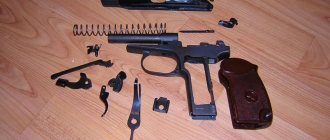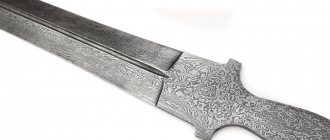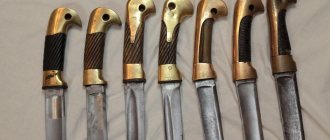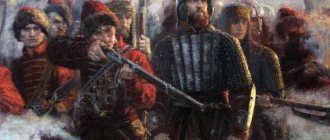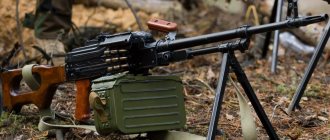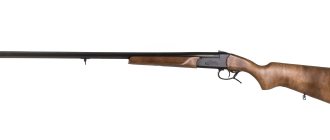The spatha is a classic double-edged sword that was used by Roman cavalry beginning in the first century BC. This is a typical weapon of Celtic foot soldiers, which soon began to be used by barbarian cavalry. It was the long swords of the Celts that served as the basis for the Roman spatha, which was produced unchanged until 600 AD.
Unlike the various types of gladius, which were mainly piercing weapons, the spatha had excellent cutting qualities, as it was invented by the barbarians, who were Germanic and Celts, and preferred to fight in crowds. It was for this reason that the Roman infantry did not use spathas, since they had gladiuses designed for powerful piercing blows. In close formations it is convenient to fight with a short sword.
History of the Spatha Sword
The first swords, similar in type to the spatha, appeared in the arsenal of Roman troops around the third century BC. The direct ancestor of this weapon is the Celtic sword, which was used by all tribes with Celtic or Germanic roots. Theories about the origin of this sword often contradict each other:
- According to one version, the Celtic sword, which became the prototype of the spatha? – this is nothing more than a modernized gladius;
- According to another version, the Celtic sword itself served first as a prototype of the gladius, and then of the spatha;
- According to the third version, the gladius and the Celtic sword developed independently of each other, and the Roman long sword appeared due to the fact that auxiliary units consisting of barbarians stubbornly preferred to use their weapons.
During the Great Migration of Peoples, it was the long Roman sword that became the basis for the famous Carolingians. Since iron armor became a real rarity during the early Middle Ages, the need to make a sharper cone disappeared. The swords received wide blades designed specifically for slashing.
The spatha remained popular until the 12th century, after which it evolved into a knight's sword, which was used to pierce armor. The period of the great migration of peoples was marked by a huge number of military skirmishes, so weapons, armor and warships until the 12th century were significantly inferior in quality to their Roman counterparts.
Names and terminology[edit]
There is no single term that can be reconstructed as referring specifically to spatha in Common Germanic. There are a number of terms and epithets referring to the sword, especially in Germanic poetry. [1]
- * swerdan
"cutting weapon" (from where the sword).
Beowulf
has the compound
wægsweord
(1489a), referring to a pattern-welded spatula (
wæg-
"wave", describing wavy patterns).
Mære maðþumsweord
"famous treasury sword" (1023a) is given to Beowulf as a reward for his heroism.
This same sword later became known as the gusweid
"battle sword" (2154a) [2] - heoru
(
heoro
,
eor
), presumably related to the name of Ares (identified with Teiwaz) by Jacob Grimm - maki
(
meki
,
mækir
,
mece
; also
hildemece
"battle sword"), found in both Gothic and Old English and Old Norse, possibly related to Greek μάχαιρα;
at any rate, the Gothic meki
in Ephesians 6:17 translates this Greek word.
The compound hæftmece
in Beowulf, literally "hilt-sword", appears to describe a sword with an exceptionally long hilt.
Slavic müčь
is usually considered as a borrowing from a Germanic word. [3]
The terms "blade", "point" or "edge", which are pars pro toto
("part as a whole") may also refer to the sword as a whole, include
- * biljo
"divider, cleaver" (West Germanic only);
a bill
can be any bladed tool, especially agricultural implements such as scythes or sickles;
complex guðbill
,
wigbill
,
hildebill
"war blade" refers to a sword, but the simplex
bill
.
Heliand (v. 4882) has billes biti
"sword bite".
There is a parallelism in the Hildebrandslied, establishing bill
and
suert
as synonyms (v. 53f.
Suertu hauwan, bretun mit sinu billiu
"[he] cuts [at me] with [his] sword, [me] low with [his] sword]"). - *þramja
"blade, blade", possibly
Tacitus'
framea þremjar
means "blades, blades of a sword" - *agjo
"edge". - ord
"dot" - * gaizo -
meaning "cutter", a common term for "spear", but in the early period may also have referred to a sword (see Bergakker inscription)
Based on evidence from Germanic mythology and Icelandic sagas, swords could also be given individual names. Examples include Högni's magical sword, called Dáinnleif
after the dwarf Dáinn (
Skáldskaparmál
),
Skofnung
and
Hviting
, two sword-names from
the Kormáks saga
,
Nægling
and
Hrunting
from
Beowulf
, and
Mimung
forged by Volund.
Origin of the term "spata"
The word "spata" is of ancient Greek origin. This term means a wide blade of a sword or simply a wide blade. Since the development of Roman weapons was influenced by Greek culture, the name of the sword is directly related to this. Even today, a modified word “spata” exists in many European languages:
- In Greek the word is “spathe”;
- In French – “epee”;
- In Spanish it is “espada”;
- In Italian – “spade”;
- In Romanian and Albanian – “spata” and “shpata”.
In all these languages, this word is translated as “sword” (spata), which suggests that the Roman long blade was used everywhere.
Transition to the Carolingian sword[edit]
Further information: Carolingian sword
Frankish sword (8th century)
In the 8th century, Frankish swordsmiths increasingly had access to high-quality steel imported from Central Asia, where a metallurgical industry had begun to develop. [17] The earliest types of "Viking swords" according to Petersen's typology (1919) date from the second half of the 8th century, while the actual "Viking sword" (and especially the Ulfbert
) appears at the turn of the century. 9th century
Use of spatha by Roman legionaries
The first spathas in the Roman army were auxiliary troops, which consisted of Germanic and Gallic warriors. The barbarians, accustomed to cutting with long Celtic swords, did not like gladiuses, which had good piercing properties, but were inconvenient for cutting. The length of the spatha of this time was about 75 cm. After some time, noticing that a long sword gives some advantage, the following troops armed themselves with them:
- Auxiliary Roman cavalry;
- Roman cavalry officers;
- Roman heavy cavalry, which consisted of German mercenaries. (In general, closer to the 3rd century AD, serving in the army became unprestigious for the Romans, which ultimately led to the collapse of the empire);
- Auxiliary Roman infantry.
Some historians believe that the spatha also appeared among legionnaires during the late empire, but it is unlikely that these swords could replace such a time-tested weapon as the gladius. In any case, the spathas that were found among the legionnaires' equipment most likely belonged to officers.
In written sources, bladed weapons such as the spatha appear in Tacitus, who described the early empire. Even then, it was mentioned in passing that the auxiliary infantry warriors of that era were armed with spathas. The blades of swords of that time had a length of 60 cm. Although Tacitus nowhere mentions what nationality the auxiliary troops were, an analysis of the finds of spathas in the territory of ancient Germany and eastern Europe hints that they were Germanic.
In any case, Roman auxiliary troops were formally considered Romans, and in the future they could receive Roman citizenship if they survived to the end of their military service.
An interesting fact that may challenge the Germanic or Celtic origin of the long sword is that the word “spata” itself does not in any way relate to the barbaric languages of Iron Age Europe. There are several ancient Old Germanic or English words such as "sweord", "bill", or other terms, but none of these words even remotely resemble the word "spata".
Gladius - conqueror of the world
We present the Roman sword at least in general terms. This is a fairly short weapon, so it seems amazing how the legionnaires conquered half the world with it.
The secret is simple. For the conditions in which the Roman legionaries fought, nothing else was required. The shape of the weapon was dictated by the conditions in which it was used.
Just imagine.
A wall of shields, above which helmets sparkle, moves towards the barbarians, and they, hastening death, run towards the legionnaires.
Hit! The troops collide, but it is impossible to break through the shield wall. The Romans take the blows on their shields and hold the line tightly.
But suddenly the monolith moves apart. For a split second, the legionnaires open their shields and inflict lightning-fast stabbing blows with their swords on the Germans.
A moment later, the shields again close into a single impenetrable wall.
Introduced? As you can see, there can be no talk of any graceful fencing with such tactics. This also explains the modest, by today’s standards, size of the sword. However, the history of the sword has been written with the short gladius for more than one or two centuries. What’s the matter, because it’s easier to reach the enemy with a long sword?
It's simple. Gladius is not just a Roman sword. This is the sword of a Roman infantryman. The cavalry used other swords, longer and therefore convenient when working from a horse.
As for the infantry, they fought in formation, that is, initially in close quarters. When the legion's formation was disrupted, and this happened in battle, the distance was reduced only slightly.
As you know, at close range a long sword loses its destructive power - the closer it is to the warrior’s hand, the weaker the blow. Therefore, in tight spaces you need a short blade. This is what the gladius became.
In addition, the relatively modest size of the sword had another big advantage. The quality of the metal from which the legionnaires' swords were forged was very unimportant. Therefore, the shorter the blade, the stronger it was.
There are four types of gladius - they are listed in this diagram in descending order:
Let's take a closer look at two of these types. So, meet the Mainz-type gladius
Characteristics of the sword shown in the photo: total length about 65-70 cm, blade length - 50-55 cm, blade width - 7 cm, approximate weight - 800 g.
The Mainz-type gladius was intended primarily for stabbing. As for the chopping, if applied awkwardly, it could even damage the blade.
However, nothing lasts forever under the sun.
Especially military affairs - here, as soon as one thing changes, everything else changes along the chain. The same thing happened with the gladius.
How the gladius has changed over time. Under each sword there is a date
The borders of the Roman Empire were constantly expanding. Along with the emergence of new enemies, the commanders made changes to their usual way of waging war, and the history of the sword took on new turns. But this did not happen in the very heart of the Empire, but in the regions where a previously unknown enemy lived.
In the middle of the first century, a new type of Roman sword sparkled on the battlefields. Now it is called the “Pompey type”. Unlike its predecessor, it was much better suited for cutting with the enemy, while its penetrating ability during a stabbing strike decreased.
Total length is about 60-65 cm, blade length is 45-50 cm, blade thickness is 5 cm, approximate weight is 700 g.
Interestingly, the status of a legionnaire was determined by how he carried his sword. Ordinary soldiers wore it on the right side, and centurions, that is, junior commanders, on the left.
Spathas from the Roman Iron Age
The Roman Iron Age refers to the period from 1 to 400 AD in northern Europe. Although these territories were not controlled by Rome, they developed under the influence of Roman culture. It is from this era that a huge number of Roman goods found in the marshes of Denmark, Holsteni and Schleswig date back.
About 90 swords, which were issued around 200-400 AD, were found in 1858 in the Nydam Mose cache, which is located in modern Denmark. Initially, these swords were classified as Roman spathas, but their quantity, and the Viking ship found there, suggests that these are locally made weapons. Some historians, who believe the legendary Beowulf was a real character, consider the swords from the Nydam cache to be the weapons of his warriors.
Links[edit]
- A monographic treatment of the issue can be found in May Lansfield Keller, Anglo-Saxon names of weapons treated archaeologically and etymologically
(1906).
See also K. Brady, "Weapons" in Beowulf" in: Martin Biddle, Peter Clemose, Julian Brown (eds.) Anglo-Saxon England
, Cambridge University Press, 2007, ISBN 978-0-521-03865-2;
Victor Levitsky, “Germanische Bezeichnungen für Schwert und semantische Typologie”, RASK - International Journal of Language and Communication
34 (2011), 3–22. - Maryon 1948, p. 74.
- An overview of alternative views is given by Lewizkij (2011).
- Leslie Adkins, Roy A. Adkins, A Guide to Life in Ancient Rome
, Oxford University Press, 1998 ISBN 978-0-19-512332-6, p. 87. - Kekaumen, Strategikon
, "Oration of exhortations to the emperor", para. 81 years old - Dorothy Whitelock, Anglo-Saxon Wills
, Cambridge (1930), 171. - Frank Sigmund in Ian N. Wood (ed.), Franks and Alamanni in the Merovingian Period: An Ethnographic Perspective
, Boydell & Brewer, 1998, ISBN 978-0-85115-723-8, p. 192. - Brady (2007: 94); L. Nees, Early Medieval Art
, Oxford (2002), 83. - Steuer, Heiko (1987). Helm und Ringschwert. Prunkbewaffnung und Rangabzeichen germanischer Krieger. Eine Übersicht
.
Studien zur Sachsenforschung. 6
. paragraph 22. - HR Ellis-Davidson. "The ring on the sword." Journal of the Arms and Armor Society
2 (1958). - Old English mǽl
has a number of meanings: “sign, mark, decoration; cross, crucifixion; armor, harness, sword; measure; time, moment in time, occasion, time of year" - Raymond Wilson Chambers, Beowulf: An Introduction to the Study of the Poem with a Discussion of the Stories of Offa and Finn
, 2nd edition (1932), pp. 349–352. - VI Evison, "On the Dover Sword-Ring and Other Sword-Rings and Beads." in Archaeologia CI
, 1967. - S. Fisher, "Typochronology of sword pommels from the Staffordshire Hoard" at https://finds.org.uk/staffshoardsymposium/papers/svantefischerandjeansoulat, 2010.
- Æ. Thompson, "STH711: Woden's Pommelcap" at https://thegns.blogspot.co.uk/2012/05/sth-711.html, 2012.
- France Theus, Janet L. Nelson (eds.), Rituals of Power: From Late Antiquity to the Early Middle Ages
, ISBN 978-90-04-10902-5, p. 425. - ↑
David Edge, Alan Williams: Some Early Medieval Swords in the Wallace Collection and Elsewhere, Gladius XXIII, 2003, 191-210 (p. 203).
- Alice Böhmer, Das zweischneidige Schwert der germanischen Völkerwanderungszeit
, Stockholm (1939).0 - Ellis Davidson, The Sword in Anglo-Saxon England: Its Archeology and Literature
, Oxford (1962). - Marion, Herbert (1948). "Nydam type sword from Ely Fields Farm, near Ely." Transactions of the Cambridge Antiquarian Society
.
XLI
: 73–76. DOI: 10.5284/1034398.
Swords from the Great Migration Period
After the barbarians destroyed Rome, long swords spread throughout Europe. Bladed weapons of that time are characterized by the following parameters:
- The length of the sword was from 71 to 81 centimeters. It was inconvenient to use such a weapon in the ranks, but for the barbarians this length was optimal;
- Small sword hilts. Such parameters were explained by the fact that the barbarians practically did not know how to fence. Judging by surviving written sources, they relied more on strength and dexterity;
- The weight of the sword ranged from 1.6 to 2.4 kg. This weight is ideal for the powerful slashing blows that the barbarians delivered with their modified spatha;
- The tip was strongly rounded. This made it possible to use lower quality steel for the sword without fear of the tip breaking;
- The blade width varied from 45 to 60 mm;
- Point – from 10 cm.
The peculiarity of the structure of these blades is that they were intended for battle with a poorly protected enemy, since armor in those days was extremely rare.
Gladius in culture
Not a single work of art dedicated to the Roman period is complete without mention of the gladius. From Thucydides to modern research, or even just artistic paintings, Romans are everywhere with these swords.
If we talk about movies, the peplum genre can best introduce this weapon. Films, both old and modern, full of inaccuracies and blunders, meanwhile are almost always true in one thing, legionnaires go into battle with swords.
True, in reality, not in one-on-one fights, but in close formation, under the clear command of centurions. And they are confident that the gladius, the weapon of the legions of Rome, will not fail.
Viking Age blades
The most popular type of spatha is the Viking Age sword, which is also called “Carolingian”. These blades had fullers to reduce weight and make the blades stronger. It was at this time that most swords began to be made by forge welding, placing a steel blade between two strips of soft iron. Cheap weapons were made from iron alone.
Since each clan tried to make its own swords, the shape of these Viking weapons was very diverse. Norwegian researcher Jan Petersen identified 26 modifications of Viking swords. In addition to double-edged blades, single-edged swords were also occasionally found. The length of the weapon increased by 10 cm, and the tip became more pronounced. This is due to the massive appearance of chain mail armor, for which a chopping blow was not always enough to break through.
Norman and Byzantine swords
Norman swords began to appear at the end of the 9th century. This weapon can be called a transitional form between the Roman classical spatha and the knight's combat sword. Norman had the following differences:
- The pommel became less massive, taking the shape of a hazelnut or even a simpler disk;
- The total length of the sword became about a meter;
- The edge became even more pronounced;
- The balance has shifted closer to the edge.
One of the most famous swords of the Norman era is that of Otto I, which was kept for a long time as a special relic. Norman swords fully emerged as a type between the 10th and 11th centuries.
As for the Byzantine spatha, it was more similar to the classic Roman weapon. There are two theories about the origin of this weapon:
- According to one of them, the Byzantine spatha appeared as a result of the continuity of the military traditions of Greece and Rome;
- According to the second, the spatha is a copy of the long sword of the Varangians, who were massively invited to Constantinople as excellent mercenary fighters.
The Byzantine spatha differed from classical Roman weapons in its length and the presence of a more developed guard.
The spatha long sword is undeservedly forgotten at the present time, although it was he who served as the prototype of all long swords of the European Middle Ages. Currently, by paying about 15,000 rubles, you can get a modern copy of this sword.
